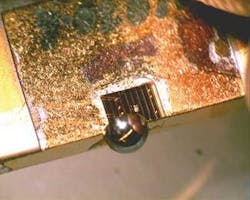TERAHERTZ SOURCES: QCLs make a difference in room-temperature terahertz

The terahertz region has long been described as the last frontier in the electromagnetic spectrum, with promises of endless applications in imaging, sensing, and security. In turn, as electrically pumped terahertz sources have been demonstrated and refined, the last frontier for them has been a demonstration of their operation at room temperature. Terahertz systems have, until now, struck a balance between complexity in room-temperature use and cryogenic cooling for simpler, more robust systems.
That final frontier has now been conquered by Federico Capasso of Harvard University (Cambridge, MA) and colleagues at Texas A&M University (College Station, TX) and the Swiss Federal Institute of Technology (Zurich, Switzerland). The team has demonstrated a room-temperature, electrically pumped terahertz source that will bring portability to the long list of terahertz radiation’s advantages.
The approach is based on quantum-cascade lasers (QCLs), which Capasso pioneered at Bell Labs in the 1990s. They are based on stacks of alternating semiconductor layers, confined in a waveguide that forms the optical cavity. With a potential applied, charge carriers cascade down the stepped potential wells of the layers, emitting photons at every step, seeding the next layer in a cascaded build-up of radiation. Because each transition between the layers is a low-energy jump, the photons are typically in the mid- or even far-infrared.
Terahertz QCLs have been demonstrated in recent years by meticulous optimization of waveguides and active regions, but unlike their mid-infrared counterparts they need to be at cryogenic temperatures to show even a modicum of efficiency. “It’s hard to get terahertz QCLs to work at room temperature because at 300 K it is difficult to inject electrons selectively only in the upper state of the laser transition,” Capasso says. “The injected electrons tend be spread out in energy by an amount comparable to the energy separation between the laser levels, making it hard to achieve the required population inversion for laser action.”
Generating a new frequency
The trick to getting around that difficulty is to exploit the natural efficiency of mid-IR QCLs and make use of a bit of nonlinear optics. The group designed a single QCL operating at two closely spaced frequencies. Through the nonlinear effect of difference-frequency mixing, those two frequencies interact in the active region’s bulk material, and a new frequency at the difference between the QCL’s two operational frequencies is generated. Voilà, terahertz.
While similar difference-frequency generation effects have been used to produce terahertz radiation in optical crystals, that approach requires much larger lasers and delicate optical setups to achieve the effect. “Our device does everything in one small semiconductor crystal with no need of bulky external laser for pumping,” Capasso says.
The team used molecular-beam epitaxy to grow alternating layers of indium gallium arsenide (InGaAs) and indium aluminum arsenide (InAlAs). Two sets of the stacks were grown, separated by an InGaAs spacer, separately optimized to emit at 10.5 and 8.9 mm. The QCLs were fabricated by placing these stacks in etched waveguides 2 mm long and tens of microns wide.
Capasso and Mikhail Belkin, two of the authors of the current study, published a demonstration of the approach at 178 K in February.1 The latest work has made the leap to room temperature by a number of optimizations. The waveguide itself has been better designed to phase-match the two QCL wavelengths and the terahertz difference frequency. What’s more, they reduced the doping in the QCLs, which in turn leads to less loss of the terahertz radiation in the cavities. With those improvements, the team showed 5 THz output radiation, with 7 mW of power at a temperature of 80 K and some 300 nW at room temperature.2
Another issue is that at terahertz wavelengths, mode-confinement issues mean that the QCLs’ output is highly divergent. The team used a recently developed approach to more efficiently couple out the terahertz, using a silicon hyperhemispherical lens—resulting in an outcoupling efficiency jump from less than 10% to more than 50%.3
Capasso says that the next step is to up the output power by greatly increasing the emitting area of the devices. As it stands, they emit from their edges, but the team plans to get the QCLs to emit from the top surface by etching a grating onto the device’s surface, scattering the terahertz vertically. “We foresee the possibility to achieve milliwatt levels of output terahertz power, which will be plenty for many applications,” he says.
REFERENCES
1. Belkin et al., Opt. Express 16, 3242 (2008).
2. Belkin et al., Appl. Phys. Lett. 92, 201101 (2008).
3. Lee et al., Opt. Lett. 32, 2840 (2007).
D. Jason Palmer | Freelance writer
D. Jason Palmer is a freelance writer based in Florence, Italy.